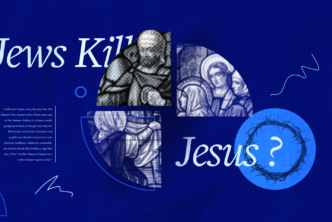Bible events have shaped more than just the history of Judaism and Christianity. They’ve impacted nearly every facet of Western civilization—from art to literature to politics to ethics.
Understanding the most important Bible stories will help you get a bigger picture of Scripture’s overarching story and its key ramifications in all areas of life.
So what are the most important Bible events to grasp?
These twenty-eight stories—fourteen from the Old Testament and fourteen from the New Testament—represent key biblical events that are important to capture the Bible’s larger narrative.
Table of contents
- The Old Testament
- 1. The creation of the heavens and the earth (Gen 1:1–31)
- 2. Story of the first humans (Gen 1:26–31; 2:8–25)
- 3. Story of the fall of man (Gen 3:1–24)
- 4. The great flood (Gen 6:9–9:17)
- 5. The story of the tower of Babel (Gen 11:1–9)
- 6. The call of Abraham (Gen 12:1–5)
- 7. The exodus (Exod 12:31–42; 14:1–31)
- 8. The Ten Commandments (Exod 20:1–17)
- 9. The conquest of Canaan (Josh 1–12)
- 10. David becomes king (2 Sam 5:1–5)
- 11. The building of the first Temple (1 Kgs 6)
- 12. The story of the northern kingdom’s destruction (2 Kgs 17:1–23)
- 13. The Babylonian exile (2 Kgs 25:1–21)
- 14. The return from exile (Ezra & Nehemiah)
- The New Testament
- 15. The birth of Jesus (Matt 1:18–2:23; Luke 2:1–10)
- 16. Jesus’s baptism (Matt 3:13–17; Mark 1:9–11; Luke 3:21–22)
- 17. The temptation of Jesus (Matt 4:1–11; Mark 1:12–13)
- 18. The calling of the disciples (Matt 4:18–22; Mark 1:16–20; Luke 5:1–11)
- 19. The Sermon on the Mount/Plain (Matt 5:1–7:29; Luke 6:29–40)
- 20. Jesus’s crucifixion (Matt 27:32–56; Mark 15:21–41; Luke 23:26–49; John 19:16–37)
- 21. Jesus’s resurrection (Matt 28:1–20; Mark 16:1–20; Luke 24:1–53; John 20:1–31)
- 22. The giving of the Great Commission (Matt 28:16–20)
- 23. The story of the day of Pentecost (Acts 2:1–41)
- 24. Persecution fuels gospel expansion (Acts 6:8–8:3)
- 25. The story of Saul’s conversion (Acts 9:1–9)
- 26. The Jerusalem council (Acts 15:1–35)
- 27. The second coming of Jesus (Rev 19:11–16)
- 28. The new heaven and new earth (Rev 21:1–5)
- Building your own biblical events timeline
- Related articles
Below you’ll find a short description of these twenty-eight events.
The Old Testament
1. The creation of the heavens and the earth (Gen 1:1–31)
The Bible starts with God’s creation of “the heavens and the earth” in seven days according to Genesis 1. The Bible describes the creation of light (day one), space and water (day two), plant life (day three), sun, moon, and stars (day four), fish and fowl (day five), and land animals and people (day six). On the seventh day, the Bible says God rests.
2. Story of the first humans (Gen 1:26–31; 2:8–25)
God creates Adam and Eve in his image, and as the pinnacle of his creation. He places them in a perfect paradise called the garden of Eden. He gives humankind a series of five commands:
- Rule over creation (Gen 1:26, 28).
- Fill the earth through procreation (Gen 1:28).
- Cultivate and care for the garden of Eden (Gen 2:15).
- Eat from any tree in the garden except the tree of the knowledge of good and evil (Gen 2:16–17).
- Name all the other animals (Gen 2:19–20).
3. Story of the fall of man (Gen 3:1–24)
A serpent tempts Eve to eat from the tree of the knowledge of good and evil by encouraging her to doubt God. After she eats the fruit, she tempts Adam, who also succumbs. God banishes Adam and Eve from Eden so they cannot eat from the tree of life and “live forever.” He also promises negative consequences from the fall: the woman’s childbirth and her relationship to her husband will both be harmed. The man will face a lifetime of strenuous and often frustrating labor. And all mankind will face their new enemy: death.
4. The great flood (Gen 6:9–9:17)
The legacy of Adam’s sin wreaks havoc in the creation over which he was made ruler. The Bible says, “The Lord regretted that he had made man on the earth” (Gen 6:6). God tells Noah to build a big boat (an “ark”) and to save a small number from every species of animal on earth; these will be protected from the great flood he is sending. Rain falls for forty days and forty nights, filling the earth with water and destroying every living being not on the boat. After the flood, God sends a rainbow as his promise never to destroy the earth through a flood again.
5. The story of the tower of Babel (Gen 11:1–9)
People attempt to build a tower in a valley in the land of Shinar in order to make a name for themselves. According to Genesis 11:5–6, God comes down to look at the tower and objects to what humans might do as a unified people; so God confuses the people’s language and scatters them.
6. The call of Abraham (Gen 12:1–5)
God calls Abram (later “Abraham”) to leave his homeland of Ur and go to a place that the Lord will later show him. He tells Abram that one day he will be the father of a great nation, will receive a special land, and will be a blessing to all families of the earth. Abram starts on the journey with his wife, Sarai (Sarah), his nephew Lot, and all of his possessions.
7. The exodus (Exod 12:31–42; 14:1–31)
Now slaves in Egypt, God calls Moses to lead Abraham’s descendants (the “Israelites”) out of bondage and toward the land he has promised to their forefathers. God brings a series of ten plagues to convince Pharaoh to let the people go. After the tenth plague, the death of every firstborn son, the Egyptian leader relents and lets the people go. As Moses leads the people out of Egypt, Pharaoh and his officials change their minds and order their soldiers to pursue the Israelites through the wilderness to the Red Sea. Trapped with the soldiers on one side and the Red Sea on the other, the Israelites cry out to God. God then divides the sea so the Israelites can cross on dry land. He crushes the Egyptians with the water when they try to pursue.
8. The Ten Commandments (Exod 20:1–17)
In the wilderness, as the Israelites encamp between Egypt and the Promised Land, God lays down a series of laws that define their relationship to one another and to him. The foundation of those laws is a series of Ten Commandments that God gives at Mount Sinai. These commandments often represent the entirety of the Mosaic law. God forbids service to other gods, idol worship, misusing the Lord’s name, murder, adultery, theft, dishonesty, and covetousness. God also tells the Israelites to honor the Sabbath and their parents.
9. The conquest of Canaan (Josh 1–12)

The book of Joshua tells the story of the Israelites entering the Promised Land and conquering the people who inhabit that land. According to Joshua 11:15–12:24, the Israelites conquer thirty-one kings and cities during this period.
10. David becomes king (2 Sam 5:1–5)
After the death of Saul and a short civil war with Saul’s son, Ishbosheth, thirty-year-old David is crowned king of a united Israel. This is the high point of a period of Israel’s history that would become known as the United Kingdom, which roughly extended from 1051 to 931 BC (the reigns of Saul, David, and David’s son Solomon).
11. The building of the first Temple (1 Kgs 6)
During the fourth year of his reign, David’s son Solomon fulfills his father’s great ambition to build a temple for God, a permanent place for him to dwell with Israel. The Bible shares an extensive record of the seven-year effort to build the temple. In total, the temple is ninety feet long, thirty feet wide, and forty-five feet high.
12. The story of the northern kingdom’s destruction (2 Kgs 17:1–23)
After years of disobedience to God, the Lord allows the Assyrians, led by King Tiglath-Pileser III and later King Shalmaneser V, to sack the northern ten tribes of Israel (Judah and Benjamin in the south are spared). The Assyrians take the Israelites captive and end their history as a distinct political entity. Eventually, the northern tribes disappear completely through cultural and marital assimilation into Assyrian culture.
13. The Babylonian exile (2 Kgs 25:1–21)
A little more than a century after the Assyrians conquer the ten northern tribes, Nebuchadnezzar and the Babylonians sack Jerusalem and deport its residents to Babylon. During the destruction of Jerusalem, the Babylonians destroy Solomon’s temple. God famously urges the exiles to ”pursue the well-being of the city I deported you to” (Jer 29:7), but we know little of the life of these exiles outside of the first six chapters of Daniel. Their experience before, during, and after the exile profoundly shapes the Old Testament.
14. The return from exile (Ezra & Nehemiah)

After seventy years in exile, Cyrus the Great decrees the return of the exiles to their homeland. The books of Ezra and Nehemiah describe three “waves” of return to Jerusalem. In the first wave, Ezra 1–3 describes a Zerubbabel-led effort to rebuild the temple. The second wave, described in Ezra 7–10, focuses on religious reform and the re-establishment of proper religious practices in Jerusalem. During the third wave, Nehemiah leads a group that rebuilds the city walls. The Old Testament story ends with a battered but partially restored Israel committing the very same sins that brought them ultimately into exile.

The New Testament
15. The birth of Jesus (Matt 1:18–2:23; Luke 2:1–10)
Two different passages in the New Testament tell complementary stories regarding Jesus’s birth. In Matthew’s version, Mary gives birth to Jesus in Bethlehem. Three wise men follow a mysterious and long-prophesied star to find the promised king. When King Herod hears this news, he orders the killing of every boy under the age of two around the town. The three wise men show up (likely around two years after Jesus’s birth) and give him gifts. In Luke’s telling, Caesar Augustus decrees that a census is to be taken. Joseph and Mary go to Bethlehem in order to participate. But when it’s time for Mary to give birth, the couple can’t find shelter. Mary ends up giving birth in a manger, “because there was no guest room available for them” (Luke 2:7). Shepherds, alerted to Jesus’s advent by angels, arrive to worship baby Jesus.
16. Jesus’s baptism (Matt 3:13–17; Mark 1:9–11; Luke 3:21–22)
Jesus launches his public ministry by coming to his cousin, John the Baptist, for a public baptism in the Jordan River. At first, John hesitates because he says he is the one who should be baptized by Jesus, not the other way around. Eventually, he relents. As Jesus comes out of the water, a dove descends upon him and a voice from heaven says: “You are my beloved Son, with you I am well-pleased” (Mark 1:11).
17. The temptation of Jesus (Matt 4:1–11; Mark 1:12–13)
After his baptism, Mark tells us that the “Spirit drove [Jesus] into the wilderness” where he fasted for forty days. Satan there tempts Jesus to take a shortcut to rule of the world by worshiping Satan. Jesus declines, quoting relevant Scriptures.
18. The calling of the disciples (Matt 4:18–22; Mark 1:16–20; Luke 5:1–11)
Jesus gathers twelve followers, mostly pulling men from the uneducated sectors of society. Jesus chooses twelve followers seemingly as a sign pointing back to the twelve tribes of Israel. As more people are added to this early movement of people following Jesus, the twelve continue to have a significant role in Jesus’s ministry. He gives them authority to represent him and his mission. The twelve eventually become the leaders of the early church after Jesus’s ascension into heaven.
19. The Sermon on the Mount/Plain (Matt 5:1–7:29; Luke 6:29–40)
Jesus gives two particularly influential sermons in the Gospels: the Sermon on the Mount in Matthew 5:1–7:29 and the Sermon on the Plain in Luke 6:29–40. In these sermons, Jesus expounds Old Testament teachings in light of his message of the kingdom.
20. Jesus’s crucifixion (Matt 27:32–56; Mark 15:21–41; Luke 23:26–49; John 19:16–37)
After the Sanhedrin convict him of blasphemy and hand him over to Pontius Pilate, the Romans viciously crucify Jesus between two criminals. At about 3:00 p.m. on the Friday of Passover Week, Jesus dies and is buried in a borrowed tomb. Remembering Jesus’s promise that he would rise in three days, Pilate orders a seal be placed on the tomb.
21. Jesus’s resurrection (Matt 28:1–20; Mark 16:1–20; Luke 24:1–53; John 20:1–31)
Three days later, an angel appears to Mary Magdalene and “the other Mary,” telling them that Jesus has arisen from the grave as he previously predicted. Jesus appears to the disciples multiple times over the next forty days before he ascends into heaven to be with the Father.
22. The giving of the Great Commission (Matt 28:16–20)
After Jesus’s resurrection and before his ascension, Jesus commissions the twelve to “make disciples of all nations, baptizing them in the name of the Father and of the Son and of the Holy Spirit, teaching them to observe everything I have commanded you” (Matt 28:19–20). These words are the driving force of Christian missions, as the church grows around the world. Other versions of the Great Commission appear in Mark 16:14–18 and Acts 1:8.
23. The story of the day of Pentecost (Acts 2:1–41)
As Jews arrive in Jerusalem for the Feast of Weeks (or Pentecost) seven weeks after the Passover and Jesus’s resurrection, God pours out the Holy Spirit upon the young church in Jerusalem. The apostles, who are gathered together in a single place, hear a sound like “a violent rushing wind” and see “tongues like flames of fire” resting on each of them. God-fearing Jews who have come to Jerusalem “from every nation under heaven” hear the apostles in their own respective languages. Quoting the Old Testament, Peter preaches a message tying the arrival of the Spirit and Jesus’s messianic identity to previous prophecies. At the end of his message, Peter urges his listeners to “repent and be baptized, each of you, in the name of Jesus Christ for the forgiveness of your sins” (Acts 2:38). More than three thousand people are saved and added to the church that day.
24. Persecution fuels gospel expansion (Acts 6:8–8:3)
After a group of Jews accuses Stephen, who was among the first deacons of the early church, of preaching blasphemy, he preaches a powerful sermon that interprets much of the Old Testament in light of Jesus. He is then stoned for blasphemy. At this point, persecution of the young church increases, and “all except the apostles were scattered throughout the land of Judea and Samaria.” As the persecution of the church grows, the church begins to spread into nearby regions.
25. The story of Saul’s conversion (Acts 9:1–9)
An eyewitness and active participant in these persecutions, Saul travels to Damascus in order to harass Christians further. On the way to Damascus, he sees a light from heaven and hears a voice saying, “Saul, why are you persecuting me?” (Acts 4). After the voice identifies himself as Jesus, the Lord sends him into the city for further instructions. Saul, blinded by the bright light, can’t see for three days and doesn’t eat or drink. A disciple named Ananias baptizes Saul, who from this time forward is known by “Paul.” He goes on to be the most influential missionary in the church’s history and to write much of the New Testament.
26. The Jerusalem council (Acts 15:1–35)
A dispute arises in the early church about how new Gentile converts will be added to the church. The apostles and elders of the early church gather in Jerusalem to discuss the issue. Paul and Barnabas tell the apostles about how God is at work among the Gentiles. The apostles determine that they “should not cause difficulties for those among the Gentiles who turn to God” (Acts 15:19). They will ask the Gentiles only to stay away from:
- Things polluted by idols
- Sexual immorality
- Eating anything that has been strangled
- Blood
This council opens the door to the spread of Christianity beyond the Jewish world.
27. The second coming of Jesus (Rev 19:11–16)

Near the end of the apostle John’s apocalyptic vision of the end times, he sees the heavens open and a white horse with a rider called “Faithful and True” who executes justice and makes war. In vivid images, John describes this rider as having “eyes like a fiery flame,” with “many crowns upon his head,” and wearing “a robe dipped in blood” (Rev 19:12–13). Because this figure has the name “king of kings and lord of lords” on his robe, he is universally recognized, although never explicitly named, as Jesus. Multiple passages in the New Testament (including Matt 24:30, Acts 1:1, and 1 Thess 4:16–17) predict this event and add further details to it.
While the timing of the Second Coming has been hotly debated throughout the history of the church, orthodox Christianity has long affirmed its eventual fulfillment through two of its most important creeds, the Apostles’ Nicene creeds.
28. The new heaven and new earth (Rev 21:1–5)
The Bible ends with a compelling picture of creation’s future. The apostle John describes seeing a “new heaven and a new earth.” This scene reverses much of what had gone wrong within the garden of Eden in Genesis 3—and restores earth to the development it was intended to have: John’s final vision is not of a garden but of a city, the New Jerusalem. John hears a booming voice announcing that God will now dwell with humanity and that he will end death forever. Then God declares that he is making all things new.
Building your own biblical events timeline
Sometimes when reading the Bible a little each day, we forget to put these biblical events above in context with one another—and with other events from world history that undoubtedly impacted one another.
That’s why it’s important to begin placing these stories on a biblical events timeline. You can do that with a pencil and paper, painstakingly plotting the dates on which the events took place and adding other major events from the world stage.
But there’s an easier way. Through the Logos Advanced Timeline (available in any package Bronze and above), you can digitally plot Bible events on a timeline along with other historical events and instantly see the important connections. Plus, these events are just a click away from more detailed information that can be pulled from your entire Logos library.
Check it out and begin building a broad picture of the Bible’s incredible story and how it has impacted the world for generations.
Related articles
- How to Study the Bible: 9 Tips
- 4 Tips for Reading the One Anothers in the Bible
- Bible Dictionaries: What They Are & Why They Matter
- 29 Bible Study Tools for Reading the Bible More Effectively








